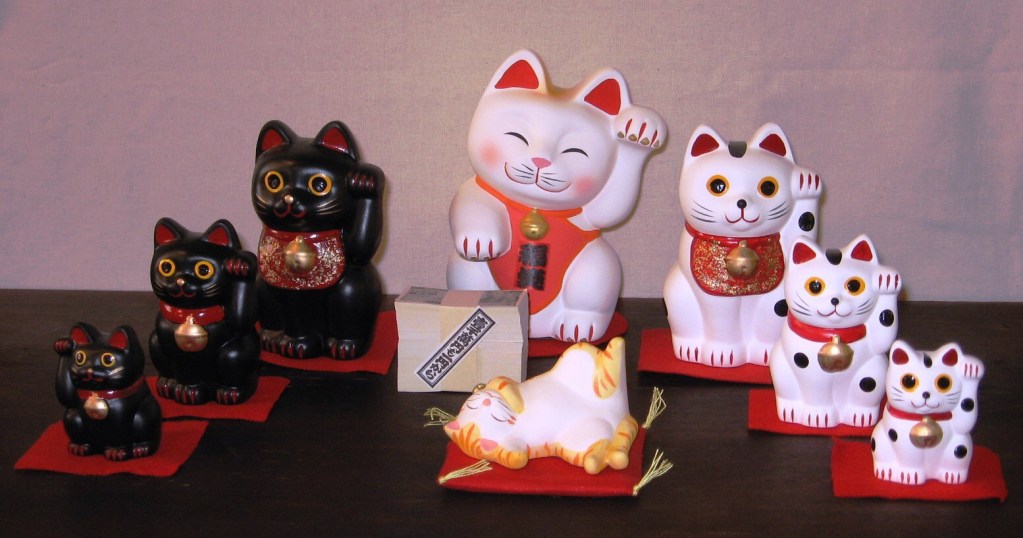Maneki Neko: history and legend of the Japanese lucky cat
4 min read
Japan is a great country for cat lovers: there are, for example, islands with more cats that inhabitants, and the most popular is Tashirojima, or you can drink something in one of the many Cat Cafes, scattered around the country even if, ironically, most apartments don’t allow pets! If you want to obtain cute cat-like items, one of the most popular is without a doubt the Maneki Neko (招き猫), also often known as Lucky Cat.
The Maneki Neko, literally the “beckoning cat,” is a very common Japanese figure. Its paw is up for inviting or welcoming passersby, and locals believe these adorable cats will bring them good luck, so they’re often displayed at at the entrance of shops, restaurants, laundromats, dry cleaners, salons, and others, as a wish for a successful business. Some of the sculptures are electric or battery-powered and have a slow-moving paw beckoning.
These days, the Maneki Neko can be found in specialty stores overseas as well.

Although there are several possible stories behind its origin, the one linked to Goutokuji Temple probably has the most veracity to it.
As story goes, around 1620, Gotokuji Temple in Setagaya-ku, Tokyo, was in a terrible state due to the financial problems that plagued it. In the small temple a poor monk lived. Even if his life was very difficult, he shared his meager meal for his cat Tama. One day, on the way home from a bird hunting trip, a samurai lord from Hikone province named Naotaka Ii decided to take a break under a big tree near the temple. Suddenly, he was caught in a thunderstorm and he saw a cat waving with its paw, as if waving him to the temple itself. Curious, he left his cover, headed for the building to have a better look at the strange cat. At the same time, a lightning bolt destroyed the same tree under which he was repairing. Nakaota was so grateful, that he donated a large sum of money to the temple afterwards. He became the patron of the temple, repaired it to become more spacious and renamed it Gotoku temple in 1697. When Tama died, he was buried in the graveyard for the cats and in the temple the statue of Maneki Neko was made to commemorate this special cat that has been born since, while the small version started being sold as a souvenir.
According to another story, the operator of an humble shop takes in a starving, stray cat despite barely having enough to feed himself. In gratitude, the cat was sitting in the front of the store beckoning customers, thus bringing prosperity as a reward to the charitable proprietor. Ever after, the “beckoning cat” has been a symbol of good luck for small business owners.

One interesting feature of the maneki neko is the gesture. Usually the Lucky Cats have one paw up, in order to attract good fortune.
However, there are different believes concerning what each paw will actually “do”: Maneki Neko can be found with either the right or left paw raised. The most common belief is that the left paw raised brings in customers, while the right paw brings wealth, good luck and health.
There are also Maneki Neko that have both paws raised. However, they are said to look like they are putting their hands up in surrender, and as such, they are not very popular. Or maybe the idea of trying to bring in customers, wealth, and good luck at the same time is a little too greedy for kind Japanese!
Others have noted the similarities between the maneki-neko’s gesture and that of a cat washing its face. There is a Japanese belief that a cat washing its face means a visitor will soon arrive.

Originally, the Maneki-Neko was only white, but over the years different colour variations were born. The original white colour is to get good luck and overall good fortune, while black is to ward off evil, red is for good health, yellow or gold is for wealth, and pink is for romance.
Lot of Maneki Neko figures are used as piggy bank and some also have a coin in their paw called “koban” (小判). Koban coins were used during the Edo Period, and the one the Maneki Neko is holding is usually worth a lot. In any case, a Maneki Neko makes for an adorable addition to your home and office, and you don’t have to worry about any deeper meaning to it. Unless you are superstitious!

Images from Web.






